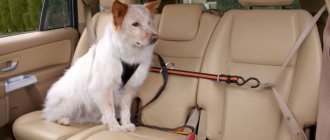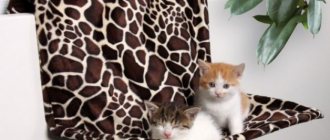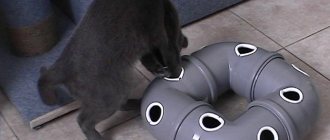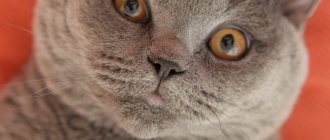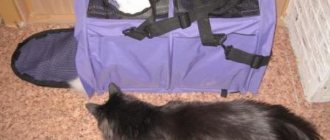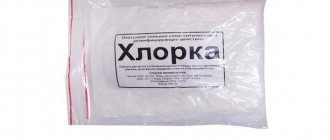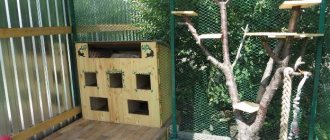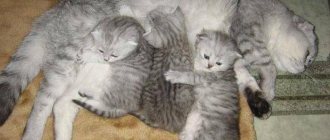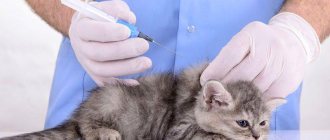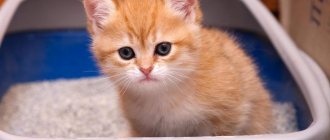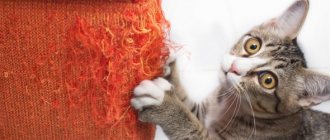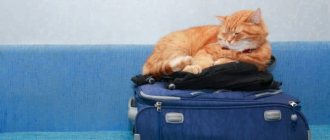Hairless breeds come to the defense of cat fashion, seeking warmth in the depths of the apartment and on the owner’s lap. Clothing for cats is not just a whim of the owner, but a real necessity. To prevent your pet from spending his life searching for warmth, you can sew him a comfortable suit that protects him from the hardships of winter.
DIY cat clothes
What to make for your pet
Cat fashion is different from human trends. It is not beauty that should come to the fore, but the convenience of the outfit. And only after ensuring the animal’s comfort can we proceed to beauty care.
First of all, clothes should be comfortable
When sewing clothes for cats, you need to build on three basic requirements:
- quality. The outfit should be as natural as possible. It is better not to use synthetic fabrics and other dubious products for sewing;
- simplicity. The costume should not consist of a dozen parts in which the animal will become entangled;
- comfort. Even in overalls, the cat remains a predator that needs to hunt, run and jump. The outfit should not hinder the movements of the fashionista.
When choosing an outfit for a cat, the owner should pay attention to the most popular items of the tailed wardrobe.
Table 1. Types of clothing for cats
| Outfit element | Image | Benefit |
| Overalls | Protects your cat from cold and dirt while walking | |
| Sweater | Warms a bald cat on cold winter evenings | |
| Mike | Lightweight outfit for the off-season | |
| Dress | Decoration for a thoroughbred lady | |
| Skirt | An element that gives the cat a feminine look |
As a rule, cats do not need hats or shoes. In addition, it will take a long time to accustom them to such outfits.
Functions of clothing for cats
Outfits for mustachioed pets can have different functionality. The model, color, and even quality will depend on the purpose of the outfit. The most popular function of cat clothes is aesthetics. This is especially true for small cats and cats. They are dressed up like children, choosing the brightest, most beautiful and practical things.
Sometimes cat owners buy clothes for their pet just to take beautiful photos
Owners of cold cats do not buy cat clothes for beauty. For example, sphinxes freeze, and not only during Epiphany frosts, but also simply on damp, rainy days. You can buy costumes for such cats for every season (summer can also be cold). And there are also cats whose coats are warm, but their paws get cold in winter. They jump onto their owner's lap to warm themselves. Of course, they don’t need a coat and a hat, but a blouse and socks are just the thing. Other cats have fluffy fur and warm paws, but their immunity is weak. Such animals can catch a cold in a draft, so they will need, for example, a vest or blanket robe to keep warm after bathing. In the summer, clothing is needed to protect the cat from overheating or exposure to ultraviolet rays.
Mine, if you don’t put him on it, won’t get out from under the blanket all day, even going to the toilet. If only you can lure him out with food. And when he's dressed, he walks around, he really likes it.
Chanterelle, forum user
https://www.u-mama.ru/forum/family/pets/673631/2.html#mid_22061402
outerwear not only keeps the cat warm, but also protects against insects
And if the cat needs periodic walks, then outerwear is one of the ways to protect against cold and rain. In addition, if you live in a private sector or there is a forest near your house, then ticks probably live on the trees. In this case, a raincoat is simply necessary. Of course, a raincoat alone will not save you from parasites, but it will make a certain contribution to protecting your pet’s health. In addition to walks, the pet can also be taken out into the world, for example, to an exhibition, on a visit, etc. In this case, an evening outfit is needed. Usually animals don’t really like such clothes, because they are not warm and cozy, but what can you do for the sake of beauty.
My cat has several homemade outfits. I don't think she likes her clothes. She loves the material from which these clothes are made, so she “endures” it absolutely calmly. For example, when it snows, she likes to watch the snowflakes fall from the balcony. I dress her, open the balcony window and stand with her.
Types of costumes for cats
Depending on what function certain cat things should perform, they are divided into several types:
- winter;
- demi-season;
- summer;
- casual;
- festive;
- protective;
- decorative
If everything is clear with seasonal clothing options, then with a weekend wardrobe everything is not so simple. For example, to participate in exhibitions you need a festive suit. This is not always easy to find in the store. Moreover, sometimes the principle of dressing such a store outfit is not at all clear. But he can impress the judges and influence the assessment.
Having seen some costumes in online stores, it is not always clear how they should be used
Taking measurements from the model
To sew cat clothes, you should take individual measurements from the model, which will allow you to draw an accurate pattern. It is not recommended to use universal templates, since even animals of the same breed can differ in size.
Basic measurements for sewing clothes for a cat
For almost any outfit you only need three measurements. Armed with tape, fix the cat in a standing position and take the following measurements:
- neck girth . The circumference of the neck is measured at its thickest point - at the base. It is advisable for the cat to stand straight at this moment;
- back length . This length is measured from the base of the neck to the root of the tail. To do this, apply the tape along the body, avoiding its bends if possible;
- chest girth . The measurement is taken around the body, placing a meter under the animal's front paws.
Some outfits will require additional measurements. For example, determine the distance between the front and rear legs or the “waist” circumference.
How to take measurements from a cat
The obtained values are transferred to paper, entering them into the pattern. When the pattern is ready, it is applied to the animal and adjustments are made so as not to redo the finished outfit later. You can read below about what measurements are needed when sewing clothes for cats.
Taking measurements from a cat
DIY cat clothes
If you haven’t found a thing that suits you in all respects, you can make the desired outfit yourself. Sewing clothes for cats is much easier than sewing for people. Here the size of the product is much smaller than that of a human suit, and the cat will not express any complaints about threads of the wrong color. To sew clothes for your pet you will need several tools:
- scissors (for cutting);
- safety pins (for cutting out);
- sewing needle (for hand sewing);
- sewing machine (if available);
- centimeter measuring tape;
- tailor's chalk or pen with light paste;
- paper (for creating a pattern).
I only sewed vests for my cat. And always only from their own sweaters and knitted jackets. Therefore, I only needed scissors and one needle for darning knitted items.
the set of necessary tools depends on the complexity of the model you will sew
How to take measurements from an animal
Taking measurements from an animal is not that difficult. The main thing is that the cat allows you to carry out these “strange manipulations with the tape” with you. It's easy to take measurements according to the instructions:
- Place the cat on its paws, measure the circumference of the neck, the length of the body from the withers to the tip of the tail, the circumference of the body behind the front and in front of the hind legs, the length of the body between the front and hind legs along the stomach, the circumference of the paws at the stomach.
- If you are sewing a jumpsuit with a hood, then you need to measure the length of the front and rear legs, the circumference of the head and the length from the base of the neck to the eyes of the cat.
- When taking measurements and designing a pattern, use one centimeter.
- Do not leave seam allowances. When taking measurements, make sure that the measuring tape is loose enough; to do this, turn it edgewise.
- If your pet is very fluffy, then take this into account.
When I used to sew for myself, I had a special notebook with models. First, I drew a thing that I would like to sew (the main thing here is not to overdo it). And next to it I wrote the measurements. By the way, it is not necessary to take measurements every time (if there is no tendency to gain weight or lose weight, you can use the same parameters). I wrote down these numbers opposite special symbols (this is convenient and saves time). OS - neck circumference, DT - body length, OG - head circumference, etc. It is convenient to use approximately the same designations in the case of cats. In addition, you can assign indices. For example, DLz is the length of the hind legs and DLp is the length of the front legs.
When taking measurements, it is necessary that the cat stands calmly on the floor
Necessary materials and patterns
To sew a good, comfortable and beautiful thing for your pet, you need to choose the right fabric. When choosing material for sewing, try to take into account the following factors:
- compound;
- ease of working with fabric;
- shrinks or fades during washing;
- Does it wrinkle a lot when worn?
- does it fade in the sun?
- How long does it retain its characteristics when worn?
When you choose fabric in a store, pay attention to the label (price tag, tag) - the composition should be indicated there. The composition of the material determines how it will wear out:
- cotton and viscose are natural hypoallergenic fibers, soft and pleasant to the touch, absorb moisture well, wash easily, do not electrify, wrinkle easily, stretch and deform when worn, and take a long time to dry;
- linen is hygroscopic, hypoallergenic, hygienic, heat conductive, reflects UV radiation (but quickly wrinkles when worn, shrinks strongly after washing, deforms during use, and crumbles heavily on cuts);
- wool fabric is a 100% natural material, resistant to wrinkles and stains, retains heat well, but forms pills on the fabric and quickly deforms when worn;
- synthetic fabrics are durable, easy to wash and retain the shape of the item for a long time, but quickly and permanently absorb unpleasant odors, are highly electrostatic, and can cause allergies in animals;
- mixed fabrics successfully combine all the positive characteristics of all types of fibers.
When choosing a fabric, it is important to consider its composition
I almost always choose mixed clothes for warm clothes. Pure wool makes me uncomfortable (it itches), 100% synthetic makes me cold. I like things with a wool/acrylic composition - 50/50. I use the same things to make vests for my cat. They are cozy, do not prick, are easy to wash, do not deform and do not fade.
In addition, you need to take into account the seasonality of the future outfit:
- winter - insulated stretch fabrics, impregnated raincoat fabric, knitted fur;
- spring - waterproof taffeta, impregnated raincoat fabric;
- summer - mixed fabrics with a high content of cotton or viscose;
- autumn - impregnated raincoat fabric, microfiber, denim material.
You have many of these fabrics at home (this way you can save money): jeans, raincoat fabric and fur. If you are going to sew winter outerwear (jacket, vest, etc.), then you will need insulation. Typically, padding polyester or holofiber are chosen for this. Now you can find ready-made raincoat fabric, quilted with synthetic padding or the same, but with a lining. The main thing is that the insulation does not prick (determine this by touch by placing the fabric on your cheek). Sometimes an important indicator is the “elegantness of the fabric”:
- excellent for everyday wear - cotton, chintz, calico, wool, flannel, flannel, fleece;
- show cat breeds “dress” in silk.
bright, silky, obviously synthetic fabrics are more suitable for sewing “smart” clothes
It is also important to take into account the color of the material, because the clothes you sew should match the exterior of your cat. Now the most fashionable colors are coral, dark turquoise and lavender. However, the color of the animal must also be taken into account. For example, dark cats (Havannah, Bombay, etc.) are more suitable for rich tones that can highlight the shine of the pet’s fur. Ginger cats and seals “suit” the same bright shades, emphasizing the individuality of the animal; for light-colored cats, choose a color that matches, for example, the eye color with the main coat color. For example, deep blue or green colors are suitable for a Turkish van.
Once you have chosen the appropriate fabric, you need to print or draw patterns. There should be several basic patterns; they can be used many times. Transfer the pattern onto paper (you can use tracing paper or draw it yourself). Don't forget to compare the pattern parameters with the measurements you've already taken.
Photo gallery: basic patterns for sewing cat clothes
on the redrawn pattern you need to put the same marks as on the sample (with their help it is convenient to connect the parts)
when drawing a jumpsuit pattern, you need to select the height to the fold of the back from points A and B
a hood made according to this pattern can be sewn to a jacket, a dress, or overalls
translate this pattern onto paper taking into account the cat’s measurements and all the indicated marks - this is a variant of overalls for the lazy
a one-piece pattern with raglan is convenient to use when sewing robes, dresses and spacious sweaters
If necessary, the patterns can be improved. For example, on a raglan pattern, you can mark the waist - this will be the cut line. The skirt is sewn on at this point. The skirt can be simple, straight (in this case it should be short). Usually a cat skirt is made with the “effect” of a train. The piece should be longer along the back than along the belly, since cats do not walk vertically, which means the front part of the product will “drag” along the floor and get in the way of the animal’s legs.
Fabric cutting, fitting and sewing
To cut out the parts you need from fabric, you need to follow simple instructions:
- Prepare the table (the table surface should be clean and level).
- Lay out the fabric on the table. It needs to be folded in half with the front side facing inward.
- Lay out the paper patterns on the fabric (check several times to see if they are lying correctly and that all the patterns fit).
- Trace the patterns with chalk (don't forget the seam allowances). To prevent patterns from slipping, they can be pinned to the fabric with safety pins.
- Remove the patterns and cut out the drawn parts. To prevent the fabric from slipping or moving, use safety pins.
When all the details are transferred to the fabric, before cutting you need to once again make sure that everything is drawn correctly. Measure the drawn parts with a measuring tape and compare these figures with the measurements. If everything is correct, then you can cut it out.
In the process of cutting out parts, the most important thing is not to rush
The double pieces will remain folded right sides inward. Along the required lines, connect the parts with a simple seam (bait). The edges of a simple seam must be fixed, otherwise the parts will come off during fitting.
You need to try on the parts separately. For example, if you are sewing a jacket with sleeves, then first you need to try on the main part (front + back), and then the sleeves - each separately. When the sleeves are sewn to the “vest,” you need to try on the jacket again. This must be done until all the parts have been collected.
If any of the parts does not fit, it needs to be adjusted (reduced or re-cut to a larger size). When all the parts are assembled, make sure that everything is correct and the product will not have to be remade. If everything is correct, then the product can be ground. To do this, the small parts are detached back and sewn together with a stronger seam in the same order as the first time. Important: do not forget to remove the thread of the simple seam after sewing each seam. For convenience, the first thread can be of a bright or contrasting color (so that it is clearly visible). After the product is stitched along all the seams, turn it inside out and try it on your pet again. The last thing you need to do is process the seams. Some seamstresses leave the inner seams unfinished, but then the cut will fray and the item will quickly become unusable. If you don’t have an overlocker and don’t want to stitch it by hand, you can use elastic bias tape.
For my cat, I sewed vests using the lazy method. We take an unnecessary jacket and check the sleeves. It is necessary that the part of the sleeve after the elbow and the cuff are in good condition. Cut off 25 centimeters from the edge of the cuff and try it on the cat. It will not be very comfortable for her, since her front legs will be immobilized. This is how I usually make sure the sleeve width is correct. Remove the sleeve from the cat and measure out the holes for the front legs. To do this, fold it so that the seam is in the middle. Conventionally, we divide the width of the sleeve (immediately above the cuff) into three parts. The two outer parts will be holes. I usually cut the holes small (about 4 centimeters in diameter). Next, we trim the cut point (this is the widest part of the workpiece) so that the estimated length of the back is a couple of centimeters shorter than the length on the stomach. We process the edges with a darning needle - the vest is ready.
a simple vest for a cat can be made in 5–10 minutes from an old sweater
Universal drawing
Most outfits can be made based on just one pattern. To create a universal drawing, you will need a sheet of paper and measurements taken from the animal. Based on the measurements, a pattern is drawn, consisting of a back and front.
All smooth curves are drawn intuitively and corrected after the first fitting. Having drawn the proposed pattern, it is necessary to make allowances for the seams, after which the parts are cut out and the image is transferred to the wrong side of the fabric.
Example of a universal drawing
For convenience, the pattern can be pinned with pins. The drawing is redrawn and cut out. Depending on the fabric chosen, a fastener is used when sewing the outfit. If you choose a knitted stretch material, you won’t need a zipper, since the vest can be pulled over the cat’s head. In the case of non-elastic materials, a fastener is sewn into the back. You can also use Velcro or buttons, but to do this you will have to adjust the back piece, leaving an allowance for the fastener.
Vest without pattern
To sew a vest for a cat, it is not necessary to draw complex patterns. All you need is an old sweater, scissors and some creative inspiration. The model in the picture shows a dog, but the proposed accessory is perfect for a cat of any breed.
Clothing suitable for both cats and miniature dogs
The step-by-step production of such a vest is presented below:
- the sleeve is cut off from a knitted sweater;
- draw a curved line with chalk next to the cut - on the stomach the vest should be shorter than on the back;
- cut off the excess along the marked line and overcast the edge. You can use either an overlocked hand stitch or an overlock stitch;
- The future vest is applied to the animal and the location of the holes for the paws is marked. The closer to the narrow edge the holes are made, the smaller the vest collar will be;
- Having folded the sleeve in half, reflect the marks for the holes symmetrically and cut them out. You can overcast the edge in any way.
After fitting, the craft is adjusted. If necessary, it can be sutured.
Video - Vest for walking
Dress for the sphinx
You can sew an original outfit for a cat using a simple pattern. An example of this will be a wonderful dress created from just two parts.
Step-by-step instructions for sewing a simple sundress
First, using the measurements taken, you will need to cut out the main part. To do this, the fabric is ironed and folded with the right side inward. A pattern is drawn with chalk on the resulting “sandwich” of fabric. In the proposed example, the back length is 26 cm. This value can be changed depending on the required length of the dress. The value equal to 17 cm in the photo indicates the length of the product on the stomach. The first fitting will help determine the length, so the fabric is cut with a margin, and later the excess is cut off.
Pattern of a sundress for a cat
Step-by-step instructions for making a dress for the sphinx consist of several simple steps:
- seam allowances are added to the part and the pattern is cut out;
- by dividing the folded fabric, you get a dress detail with two cutouts for paws. Having attached the part to the animal, mark the required length and adjust the dress;
- the armholes of the sleeves and the bottom of the product can be edged with tape or hemmed by machine, turning the fabric 3 mm;
- the part is sewn together. The seam should be on the front of the product;
- You can use cuffs from any sweater or a strip of elastic fabric as the neckline of the dress. The rectangle of material should have a length equal to the circumference of the cat's neck. The strip is sewn into a ring and folded in half, after which it is attached to the product.
The dress can be decorated in any way you like. For example, create an applique from fabrics or sew on buttons and other decorative elements.
Video - Denim collar-vest with removable wings for a cat
Comfortable and stylish pajamas
Cats are heat-loving animals, especially if you have a Sphynx living in your apartment. Pets with smooth coats require special attention, so comfortable pajamas are the ideal solution for caring for your four-legged animal. For this pattern of clothing for cats, any soft fabric, such as flannel, fleece or jersey, is suitable; it is better to use waterproof options. This option is printed on A4 sheets or applied independently to whatman paper.
Read also: How to start doing yoga at home and what you need for it
Step 1. This model consists of several parts. Part 1 – back (GZ), the value is equal to the length of the cat’s back; you can also place a fastener along this line (for this you need to leave an allowance of two to three centimeters). Detail 2 (IZ) – belly measurement, folded along the IZ line.
Step 2. Place the pieces together and sew. The lines AG, BV, VD, DE are sewn together, the rest remain free (AB and EZh are the paws). The ZhZ line also needs to be sewn, but leave a small hole for the tail. When the work is ready, sew on a zipper if desired.
Some tips for sewing: make the seams overlap, using a zig-zag stitch, in this case they will be softer and will not disturb your cat. The lower edges of the paws and throat can be supplemented with a pre-prepared knitted ribbon. If the pajamas are made from fleece, the fabric does not need to be improved in this way.
The tuxedo
You can sew a wonderful tuxedo for your cat as a stylish accessory. Using a simple pattern, you can make a jacket-cape that will not hinder movement and will give your pet comfort.
For work you will need the following materials:
- white fabric - an old T-shirt;
- black material - any piece of cotton of a suitable size;
- a piece of red felt;
- Velcro for fasteners;
- scissors, chalk and other tailor's little things.
Necessary materials for work
Step 1. To determine the length of the tailcoat, measure the length from the neck to the tail of the cat. A pattern of a white element is cut out of white fabric in accordance with the measurements. For convenience, use a fabric folded in half. You will need 2 of these parts.
Cutting out the details for the tailcoat
Step 2. The first white piece, folded in half, is applied to the black fabric. The dark element should not be the same size as the white one, as the jacket will end up being shorter than the shirt.
Cutting out parts from black fabric
Step 3. You can choose any shape of the vest itself. The main thing is that it is symmetrical.
Combining the details
Step 4. A tie is cut out of red fabric, and a collar is made from a white scrap.
Cut out and apply the tie and collar
Step 5. Next, the parts are sewn together in the following order:
- a tie with a collar is attached to the base;
- a vest is attached to the upper white part;
- the protruding part of the tie is sewn on top;
- Velcro is sewn to the elongated neck so that the upper part tightly covers the lower one.
Sew the parts and attach Velcro
Step 6. The future tailcoat will be attached to the pet’s neck and stomach. As a fastener, cut out a rectangular strip of black color and add 0.5 cm to its edges.
Making a fastener
Step 7. The resulting strap is sewn between two white parts of the tailcoat. The length of the belt is determined by the circumference of the pet's chest. It is best to adjust this length during fitting. The edge of the cut belt is lined up. Strong Velcro is sewn onto one end of the tape.
Sewing the tailcoat and fastening
Step 8. The second Velcro piece is sewn on the opposite side of the white piece inside out, as shown in the picture. The fastened strap will go around the animal's chest. To make the tailcoat look stylish, its edge can be ironed and stitched 1 mm from the edge.
Ready-made tuxedo
The finished tuxedo will serve as an excellent cape for a freezing Devon Rex.
Airy skirt
Clothes for cats are needed not only to keep your pet warm, but also for going out into the world. Thus, show animals often appear before judges in exclusive outfits. Skirts are especially relevant in cat fashion, giving femininity and charm to sophisticated breeds.
To create such an unusual accessory you will need:
- tulle;
- satin ribbon;
- scissors.
The easiest way to create a fluffy ballet tutu does not require any drawings or patterns. To sew a skirt, just measure the cat’s “waist” circumference and add 10 cm to this value.
Required materials and work process
The satin ribbon is cut to the obtained length. The tulle is cut into strips 2 cm wide. The length of the strips is equal to the required length of the skirt multiplied by 2.
Next, the tulle strips are folded in half and tied onto a satin ribbon with loose knots, as shown in the photo. The thicker the ribbons are tied, the more magnificent the pack will be. To add volume to the product, the length of the strips can be varied. To create color transitions, tulle of various shades is used.
How to cut and attach ribbons
When all the stripes are tied on a ribbon, the skirt is tried on the cat. The free ends of the tape are tied on the back of the animal and their length is adjusted.
Ready-made skirt
Sweater with pattern
Before you start knitting a sweater, take a tape measure and measure the volume of your pet's neck and the approximate length of the sweater. When you make a cutout for the neck, do not make it small, otherwise the cat will be uncomfortable.
To work you need:
- knitting needles number 3.5
- circular needles number 3.5
- yarn 100 grams (wool or 50/50 with acrylic)
- needle
Let's get started
The main pattern is stockinette stitch. Knit over knit, purl over purl. Knitting density: 16 loops / 20 rows = 10 / 10 centimeters. We knit in 2 threads.
Let's start work from the front. We put 25 loops on the knitting needles and knit them with an elastic band, knit 1. 1 purl. 3 centimeters. Then we continue working with stockinette stitch to a height of 10 centimeters. The pattern has it all. 13 centimeters from the edge, to form sleeves, we cast on 18 loops on both sides of the fabric (a total of 61 loops on the knitting needles). We knit 10 centimeters exactly with the front ones and for the neckline we close off 21 loops in the middle. (20 loops remain on the knitting needles). In the next row, add 28 stitches above the closed stitches. (There were 68 loops on the knitting needles). Knit another 10 centimeters in stockinette stitch with an even fabric and bind off 18 stitches on both sides. (There are 32 loops on the needles). After another 10 centimeters, elastic 1/1 (k1, p1). Knit an elastic band 3 centimeters. Close the loops without tightening them too much.
Assembly
Sew the side seams and sleeve seams. Making a neckline: cast on loops on circular knitting needles and knit as many centimeters as you want for the collar. You can make the collar high, or you can just make it a few centimeters. We knit with a 2/2 cm elastic band. The main thing is that the cat is comfortable.
The video provides detailed information on how to crochet a sweater for a dog, but this sweater is also suitable for our beloved Sphynx .
how to crochet a dog sweater
Insulated option for walking
Fashionable clothes for a cat can not only be sewn, but also knitted. A simple vest design for an adult pet will help with this.
To make clothes bring comfort and joy, you need to choose natural threads. Acrylic thread or angora yarn will also work. You will also need knitting needles. Their diameter is determined by the thickness of the yarn, and the recommended tool number is indicated on the thread packaging.
Vest diagram
On a note! Before knitting, it is recommended to wash the threads in warm water and dry them in fresh air. Do not use washing powder with a strong odor. Hairless cats often face skin problems, allergies and other troubles.
Sweater with a pattern
You can knit a gorgeous sweater with a pattern for your pet. It will be more complicated than the previous one, but it will look very interesting. It’s up to you to decide which sweater to choose.
For this sweater we will need:
- knitting needles number 3.5
- yarn 100 grams (light and dark) wool or 50/50 with acrylic
- needle
Knitting density 16 p. / 22 rows = 10/10 cm. Cast on 48 loops with blue thread and knit with a 2/2 elastic band. Switch to a white thread and knit 5 cm in stockinette stitch. Next, start knitting the pattern according to the pattern:
Scheme
At the same time, knit the holes for the paws: knit 7. loops, cast off 6 loops, knit 22. loops, close 6 loops. 7 persons. loops Knit the resulting 3 parts separately for the next 5 centimeters, then connect them by casting 6 loops above the closed loops. After 20 centimeters from the neck, start decreasing (3 times 3 loops on both sides). Close off the remaining stitches after finishing the pattern. Along the edges of the holes for the cat's paws, cast on 20 loops with a dark thread and tie 4 centimeters with a 2/2 elastic band. The sweater is ready.
Emergency heating
It happens that you need clothes for a cat urgently. There is not enough time to create a pattern and sew it. This happens when a frozen kitten is nailed to the house in winter. To quickly warm him up, you can make a simple outfit out of a regular sock.
What you will need:
- an old warm sock without a pair;
- scissors;
- chalk.
Sock cat vest
To make a simple vest from scrap materials, you don't need sewing skills. Even a child can cope with this task, since it includes several simple steps:
- The sock is applied to the pet and the length of the future product is measured with a small margin (1 cm). Mark the cutting line with chalk;
- the sock is folded and ironed, then the excess is cut off;
- After this, the position of the holes for the paws is noted. It is important to draw them symmetrically. To ensure that the vest has a wide collar, holes are drawn in the middle of the sock;
- longitudinal holes are cut with scissors. If desired, they can be overcast with a hand seam or use an overlocker;
- try the products on the cat. You should check whether she is tight in such an outfit. To do this, place your palm under the sock. If the hand fits in freely, the outfit is sewn to size. The neck area is also checked.
An outfit made from a sock cannot claim to be a fashion item in a cat's wardrobe. However, in difficult situations, such a suit can warm a small pet and give him a sense of security.
Video - How to make clothes for a cat with your own hands
Summer minimalism
Cats only need casual outfits during the cold season. In summer there is no need for insulation, but there is a need for a stylish appearance. To add some flair to your cat's image, but not to overdo the outfit, you can make a cute accessory for your pet - a bow tie.
By the way! The textile highlight is also useful for photo shoots when the animal urgently needs to find a home or introduce the cat to the public.
Bow tie for a cat
For sewing you will need:
- thick fabric;
- collar (you can use a flea collar);
- needles, thread and scissors.
To ensure that the butterfly does not interfere with the cat’s enjoyment of life, you need to choose the appropriate size of the craft. Firstly, the product should not be too large. A bulky accessory will disturb the animal while eating and irritate it the rest of the day. Secondly, the craft should not have an intrusive smell, rustle or put pressure on the throat.
Step 1. Cut out a rectangle with sides 25 cm and 13 cm from thick fabric. It is also necessary to prepare a jumper for the butterfly. Its dimensions are 6x4 cm.
Tie details
Step 2. If the cat does not wear a collar, a strip of the same fabric will be useful for the tie, which will become a fastener. Its dimensions are 50x5 cm. A long piece of fabric is folded in half lengthwise and stitched. A fastener is attached to the ends of the tape.
Sew the main part for the bow tie
Step 3. A 25 cm piece is folded in half and stitched into a ring. Next, this part is folded so that the line is in the middle.
We sew a ribbon for a tie and sew on a hook
Step 4. A small jumper section is sewn into a miniature ring by hand, going around the main part. The butterfly is straightened and the jumper is secured in the middle of the craft with a hidden stitch from the inside. A part with clasps or a collar is inserted under the ribbon.
Video - Festive butterfly for a cat
How to train a cat to wear clothes
Regardless of the breed, most adult cats react violently and negatively to the appearance of clothing in their lives. If the animal has not been dressed up before, it will be extremely difficult to accustom it to fashion. It is better if the first beauty session occurs in childhood. It is easier to teach a kitten not only the rules, but also “manners”. It is recommended to start inoculating the culture when the kitten reaches 1 month. The first outfits should not restrict movement or cause discomfort. It is better to choose natural lightweight fabrics in which the cub will be comfortable to run and play with other kittens.
It's easier to train a kitten to wear clothes
By the way, a cat mother may not understand a stylish look - it will interfere with caring for the baby. Therefore, it is better to carry out the first fittings when the cat is away on business. It is better to switch to constant wear after the kittens are weaned from their mother.
Attention! Kittens are not very clean creatures, so with the decision to dress up your pet, the decision to wash his clothes should also mature. This is especially true for hairless breeds, whose skin secretes a special secretion.
How to choose fabric?
Cat outfits can be made from any material. Synthetic products are quite durable. They can withstand washing at high temperatures without changing shape. But this fabric has electrostatic properties and is not suitable for furry animal costumes. In addition, synthetics can provoke allergic reactions. Therefore, it is better to sew clothes for cats with your own hands using natural materials, such as:
- Cotton fabric. Soft fabric with excellent hygroscopicity. Cotton products are quite practical and even after repeated washing they do not lose color and shape.
- Viscose. An artificial material made from natural raw materials that has the same properties as cotton.
- Wool fabric. An excellent option for sewing a winter wardrobe. Retains heat well, does not wrinkle and is resistant to stains. During long-term use, pellets form on its surface. However, this drawback can easily be eliminated using a conventional razor.
- Linen. 100% natural material that is hypoallergenic. Conducts heat well and protects from sunlight. The fabric requires delicate care, so such clothes must be washed in water at room temperature, otherwise the product will shrink in size.
Another option is mixed fabrics. They contain about 40% cotton, the rest are synthetic fibers. This combination gives the material properties such as strength, elasticity, wrinkle resistance, and damage resistance. Items made from this fabric are practical and have a long service life.
Bride
If you need to sew winter clothes, then it is better to use synthetic winterizer as insulation. It is soft, lightweight, does not absorb odors and does not require special care. Holds heat well and is resistant to deformation.
Fashion trends in the cat world
Craftswomen and cat lovers never tire of creating new and original clothing models for cats. Every year, unusual outfits for pets of hairless breeds become the rage.
Lace, which is firmly entrenched in the top of the best outfits for cats, does not lose its relevance.
Dress with lace for cats
The sweater is a warm classic for fashionable pets.
Knitted sweater for a cat
Casual outfit for a cat
Festive costume
Clothing for a cat is a way not only to keep your pet warm, but also to give it a unique personality. Even a novice seamstress can sew stylish things for a pet. To do this, it is enough to arm yourself with a creative mood and simple patterns of cat outfits.
